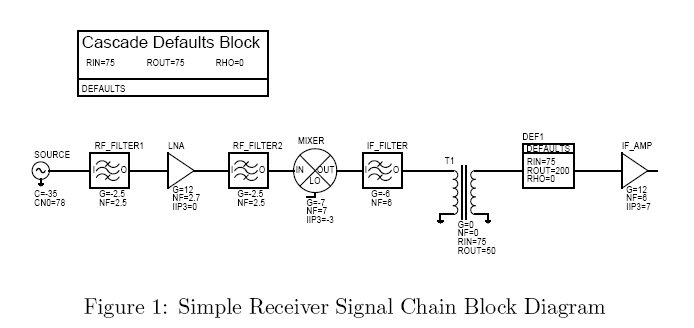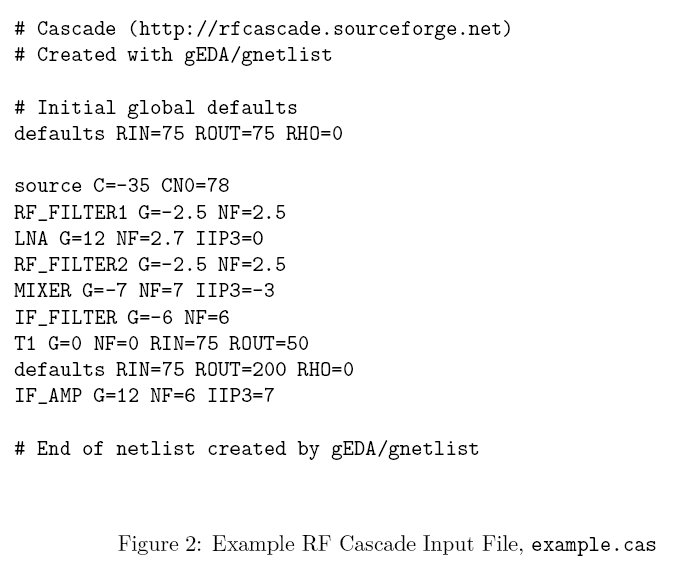Table of Contents
gEDA/gaf RF Cascade Symbols and Netlister
Overview
This document describes the symbol library and gnetlist backend which support driving RF Cascade (http://rfcascade.sourceforge.net) simulations from the gEDA/gaf system. Cascade is a noise figure and distortion analysis tool geared towards radio receiver design.
The basic steps involved with using gEDA as the frontend for Cascade simulations are:
- Create schematics of the circuit.
- Extract the netlist.
- Run Cascade.
Requirements
You will need the following programs to be installed:
- A recent version of gEDA/gaf. To see if your version is recent enough, see if the directory
$prefix/share/gEDA/sym/cascadeexists.$prefixis the installation prefix for gEDA on your system. - RF Cascade. The executable is usually called cascade. If you do not have Cascade available on your system, you will need to get a copy from http://rfcascade.sourceforge.net.
Creating Schematics
When creating a block diagram in the gschem schematic editor, use only the symbols from the cascade library. Every block diagram must have a \cascadesource“ element. In addition, the block diagram must be a simple cascade. No parallel paths or branches are allowed.
All instances must have a unique reference designator. For a receiver block diagram, this is often times best achieved by manually entering them. The only restriction on reference designator names is that they contain no spaces. A descriptive name such as \RF Filter” or \First Mixer“ is useful as it will show up in the cascade output report.
Extracting the Cascade Input File
To extract the Cascade input file, run:
gnetlist -g cascade -o test.cas file1.sch [file2.sch ...]
For the example file contained in this archive, you can run:
gnetlist -g cascade -o example.cas example.sch
The netlist will be left in example.cas.
Running Cascade
Cascade is exceptionally simple to run. Just run:
cascade example.cas > example.out
to run the analysis on the system contained in the file example.cas and write the results to the file example.out. Refer to the Cascade documentation for complete details.
Appendix A -- Symbols in the Library
Please note that all instances must have the refdes= attribute set.
Sources (cascade-source)
Source. Attributes:
- C=Carrier level in dBm. Optional.
- CN0=Carrier to Noise Spectral Density Ratio in dBm/Hz. Optional.
- CN=Carrier to Noise Ratio in dB. Optional.
- BW=Signal Bandwidth in Hz. Optional, but requred if CN= is used.
Defaults (cascade-default)
This symbol sets the default impedance levels as well as the correlation coeffcient used for third order distortion calculations. There are two versions of this symbol. One is used to set the defaults at the beginnng of the definition. The other can be placed in series with the cascade to change the defaults part way through. This is useful if you wish to change impedance levels in the middle of the receiver chain. Attributes:
- RIN=Default block input resistance in Ohms. Optional.
- ROUT=Default block output resistance in Ohms. Optional.
- RHO=Default third order distortion correlation coeffcient. Optional.
Elements
Cascade characterizes each block in a system by its gain and optionally noise figure and third order intercept point. As such, there is no distinction between various elements such as amplifiers, filters, and mixers. The gEDA/gaf RF Cascade symbol library contains different symbols for clarity in the diagram only. The currently available element symbols are: Attributes:
| cascade-amp | Amplifier |
| cascade-filter | Filter |
| cascade-mixer | Mixer |
| cascade-transformer | Transformer |
| Table 1: Element Types | |
- Gain is specified by one of the following:
- G=Power gain in dB.
- GP=Power gain in dB.
- GV=Voltage gain in dB.
- NF=Noise Figure in dB. Optional.
- IIP3=Input Third Order Intercept Point in dBm. Optional.
- RIN=Block input resistance in Ohms. Optional.
- ROUT=Block output resistance in Ohms. Optional.
- RHO=Third order distortion correlation coeffcient. Optional.
Example
This appendix provides a simple example of the entire process of generating a schematic, producing a Cascade input file, running an analysis and looking at the result.
Example Schematics
Figure 1 shows the schematic of a simple receiver signal chain.
Figure 2 shows the contents of the example.cas file.
Netlist the Design
To netlist the design, run:
gnetlist -g cascade example.cas example.sch
Run the Analysis
Run the analysis with:
cascade example.cas
Document Revision History
| December 3rd, 2003 | Created cascade.tex |




